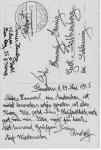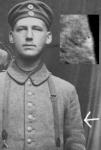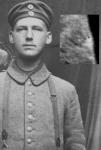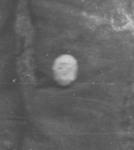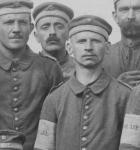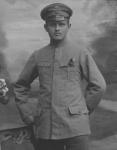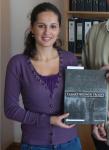
Thomas W
For Deletion-
Posts
788 -
Joined
-
Last visited
-
Days Won
3
Content Type
Profiles
Forums
Blogs
Gallery
Events
Store
Everything posted by Thomas W
-
Two or three gas pioneers were assigned to each infantry assault squad during an operation. In the photo, there are two gas pioneers armed with rifles and equipped in light assault order. The second gas pioneer in the photo wears colored brassards on both sleeves, identifying him as a member of a shock troop. I'm saving the photo for my book on German assault troops, so I can't post the whole thing here. The abbreviation may have something to do with gas pioneers who were assigned to infantry shock troops.
-
Upper. The problem is that the man moved as the photo was being taken. His friend is standing perfectly still, but the man with the sleeve badge was swaying, and the image is just blurry enough to make it indistinct. As I said before, I've identified 15 different unofficial shock-troop badges. I haven't seen any other photos of them or seen any mention of them in any source. Your badge is almost certainly unofficial, Robin, so it wouldn't be found in any regulations.
-
According to writing on the back of the card, this Pionier is a member of 15 tum.(?), II Batl., 6th Comp., Pionier Regiment 35. The card is dated May 29, 1915, and says "Greetings from Flanders." Pionier-Regiment 35 was established March 29, 1915. It had two battalions of 3 companies each. Pio-Reg 35 carried out its first gas attack April 22, 1915, north of Ypres. The second gas regiment, Pionier-Regiment 36, was established in May of 1915. In August of 1917 both regiments were dissolved and replaced with Pionier-Bataillone 35-38. In February of 1918 Pionier-Batailon 39 was added, and in June Bataillone 94-96 were added. By the end of the war there were eight gas battalions. This sleeve badge must be unofficial. I have identified about 15 different unofficial sleeve and shoulder-strap badges for assault troops. I have never seen them in other books or photos, so now I think there is a real chance that Robin's badge is authentic. You can see that in this photo the skull(?) has a very crude shape. It seems likely that by the end of the war the gas troops would want a nicer badge. They probably knew about the flamethrower badges, so maybe somebody decided to copy the flamethrower badge in black.
-
I think it may be a shock-troop badge. I've got photos of about fifteen different unofficial sleeve and shoulder-strap badges worn by the shock troops and assault squads of various units. "Instructions for the Training of Shock Troops," from Anleitung für Kompagnieführer, recommends that "A special badge on the sleeve or shoulder strap facilitates the recognition of shock troops and raises the self-confidence of the men."
-
Photos of tanks from the Great War
Thomas W replied to Freiwillige's topic in The Great War 1914 to 1918
The M1917 Six-ton Tank was the American version of the FT-17. Only 64 Six-ton Tanks had been built by the Armistice, and it didn't see action. It differed from the Renault in that the exhaust pipe was on the opposite side. (This photo is actually an FT-17.) http://afvdb.50megs.com/usa/pics/m1917.html -
As soon as I finished that flamethrower book the publisher asked me to write a book about German assault troops that I just finished. It's incredible the number of unofficial shock-troop badges there were. The new book will show several different "S" badges, colored rectangles, wreaths, an "H" badge on the shoulder strap (for "Handgranate"), numerals, crossed grenades, single grenades, and a chevron, all (except the "H") on the upper left arm or left elbow. All are in period photos, not modern collections. Besides the grenade and crossed-grenade badges, none of these have been described in any sources I've seen. None were authorized, either, so it's not out of the realm of possibility that someone would knock up an unofficial black-skull badge. The Austrians based their own assault-troop badges on the skull worn by the flamethrower platoon of Sturmbataillon Nr. 5 (Rohr), which trained the Austrians. Prior to the k.u.k. Sturmtruppen, the Austrians had no tradition of Totenkopf badges. Since Sturmbataillon No. 5 (Rohr) was the premier shock-troop training organization, it's possible that some Germans or Turks were so impressed by the nifty skull badge worn by their instructors that they made a similar badge for themselves. As for your age, I'm 48. The day I choose old postcards over gorgeous Bulgarian women is the day I lie down and pull a dirt blanket up over my head!
-
Young man, I worry about you. There's more to life than skulls! But I appreciate the thanks. (The publisher still has my !@#$%^&* photo collection, by the way. The very dark Totenkopf is on page 67 of the book, under the chapter on the Ottoman Empire. I was going to scan it and post it here, but when I enlarged it, all I could see was dots. I have to wait until my collection is returned to me.)
-
Photos of tanks from the Great War
Thomas W replied to Freiwillige's topic in The Great War 1914 to 1918
Those kinds of mistakes are very common in commercial postcards. One of the most famous is this one, which show French troops operating flamethrowers, but the caption says, "Giving the Germans gas. French officers, American infantry. France."

